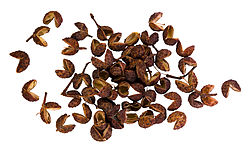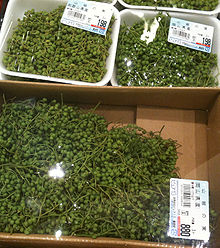- Sichuan pepper
-
Sichuan pepper 
Chinese 花椒 Transcriptions Mandarin - Hanyu Pinyin huājiāo Sichuan pepper (or Szechuan pepper) is the outer pod of the tiny fruit of a number of species in the genus Zanthoxylum (most commonly Z. piperitum, Z. simulans, and Z. schinifolium), widely grown and consumed in Asia as a spice. Despite the name, it is not related to black pepper or to chili peppers. It is widely used in the cuisine of Sichuan, China, from which it takes its name, as well as Tibetan, Bhutanese, Nepalese, Japanese, Konkani, and Toba Batak cuisines, among others.
It is a close relative of the African spice uzazi.
Contents
Names
 Recently harvested Sichuan pepper (known locally as 大红袍花椒, Da hongpao huajiao[1]), being dried on the roadway in Linxia County, Gansu
Recently harvested Sichuan pepper (known locally as 大红袍花椒, Da hongpao huajiao[1]), being dried on the roadway in Linxia County, Gansu
Sichuan pepper is known in Chinese as huājiāo (花椒; literally "flower pepper"). A lesser-used name is shānjiāo (山椒; literally "mountain pepper"; not to be confused with Tasmanian mountain pepper), which is also the root of the Japanese sanshō (山椒). Confusingly, the Korean sancho (산초, 山椒) refers to a different if related species (Z. schinifolium), while Z. piperitum is known as chopi (초피).[2]
The Indian subcontinent uses a number of varieties of Sichuan pepper. In Konkani it is known as tephal or tirphal.[3] In Nepali, Z. alatum is known as timur (टिमुर), while in Tibetan, it is known as yer ma (གཡེར་མ)[2] and in Bhutan as thingay.[citation needed]
In Indonesia's North Sumatra province, around Lake Toba, Z. acanthopodium is known as andaliman in the Batak Toba language[2] and tuba in the Batak Karo language.[citation needed]
In America, it is possible to come across names such as "Szechwan pepper," "Chinese pepper," "Japanese pepper," "aniseed pepper," "Sprice pepper," "Chinese prickly-ash," "Fagara," "sansho," "Nepal pepper," "Indonesian lemon pepper," and others, sometimes referring to specific species within this group, since this plant is not well known enough in the West to have an established name.[citation needed] Some brands also use the English description "Dehydrated Prickly Ash" since Sichuan pepper, and Japanese sansho, are from related plants that are sometimes called prickly ash because of their thorns.
Culinary uses
Sichuan pepper has a unique aroma and flavour that is not hot or pungent like black or white pepper, or chili peppers. Instead, it has slight lemony overtones and creates a tingly numbness in the mouth (caused by its 3% of hydroxy-alpha-sanshool) that sets the stage for hot spices. According to Harold McGee in On Food and Cooking, second edition, p429 they are not simply pungent; "they produce a strange tingling, buzzing, numbing sensation that is something like the effect of carbonated drinks or of a mild electrical current (touching the terminals of a nine-volt battery to the tongue). Sanshools appear to act on several different kinds of nerve endings at once to induce sensitivity to touch and cold in nerves that are ordinarily nonsensitive. So theoretically may cause a kind of general neurological confusion."
Recipes often suggest lightly toasting the tiny seedpods, then crushing them before adding them to food. Only the husks are used; the shiny black seeds are discarded or ignored as they have a very gritty sand-like texture. It is generally added at the last moment. Star anise and ginger are often used with it prominently in spicy Sichuan cuisine. It has an alkaline pH and a numbing effect on the lips when eaten in larger doses. Ma la (Chinese: 麻辣; pinyin: málà; literally "numbing and spicy"), common in Sichuan cooking, is a combination of Sichuan pepper and chili pepper, and it is a key ingredient in má là hot pot, the Sichuan version of the Chinese traditional dish.
Sichuan pepper is also available as an oil (Chinese: 花椒油, marketed as either "Sichuan pepper oil", "Bunge Prickly Ash Oil", or "Hwajiaw oil"). In this form it is best used in stir-fry noodle dishes without hot spices. The preferred recipe includes ginger oil and brown sugar cooked with a base of noodles and vegetables then rice vinegar and Sichuan pepper oil are added after cooking.
Hua jiao yan (simplified Chinese: 花椒盐; traditional Chinese: 花椒鹽; pinyin: huājiāoyán) is a mixture of salt and Sichuan pepper, roasted and browned in a wok and served as a condiment to accompany chicken, duck and pork dishes. The peppercorns can also be lightly fried in order to make a spicy oil with various uses.
In Indonesian Batak cuisine sichuan pepper is ground and mixed with chilis and seasonings into a green sambal Tinombur or chili paste, to accompany grilled pork, carp and other regional specialities. Arsik in one of Batak Tapanuli dishes which use Shinchuan pepper as spice.
Sichuan pepper is one of the few spices important for Nepali (Gurkha), Tibetan and Bhutanese cookery of the Himalayas, because few spices can be grown there. One Himalayan specialty is the momo, a dumpling stuffed with vegetables, cottage cheese or minced yak meat, beef or pork and flavoured with Sichuan pepper, garlic, ginger and onion. The noodles are steamed and served dry, together with a fiery sauce. It is believed that it can sanitize meat that may not be so fresh, although in reality it may only mask foul flavors. The foul smell masking property of Sichuan pepper made it popular in offal dishes[citation needed].
In Japan the dried and powdered leaves of Zanthoxylum sancho are used to make noodle dishes and soups mildly hot and fragrant. The whole fresh leaves, 木の芽 kinome, are used to flavour vegetables, especially bamboo shoots, and to decorate soups. Typically the young shoots are used in this way giving an aromatic lemony flavour to food. They are used to denote spring seasonality in food. The buds, seeds, flowers, and hulls are also used.[4]
Sichuan peppercorns are one of the traditional ingredients in the Chinese spice mixture five-spice powder and also shichimi togarashi, a Japanese seven-flavour seasoning.[5]
In Korean cuisine, two species are used: Z. piperitum and Z. schinifolium.[6]
Composition of various species
- Z. fagara (Central & Southern Africa, South America) — alkaloids, coumarins (Phytochemistry, 27, 3933, 1988)
- Z. simulans (Taiwan) — Mostly beta-myrcene, limonene, 1,8-cineole, Z-beta-ocimene (J. Agri. & Food Chem., 44, 1096, 1996)
- Z. armatum (Nepal) — linalool (50%), limonene, methyl cinnamate, cineole
- Z. rhesta (India) — Sabinene, limonene, pinenes, para-cymene, terpinenes, 4-terpineol, alpha-terpineol. (Zeitschrift f. Lebensmitteluntersuchung und -forschung A, 206, 228, 1998)
- Z. piperitum (Japan [leaves]) — citronellal, citronellol, Z-3-hexenal (Bioscience, Biotechnology and Biochemistry, 61, 491, 1997)
- Z. acanthopodium (Indonesia)
The genus name Zanthoxylum or Xanthoxylum comes from the Greek xanthon xylon (ξανθὸν ξύλον), meaning "blond wood."
US import ban
From 1968 to 2005, the United States Food and Drug Administration banned the importation of Sichuan peppercorns because they were found to be capable of carrying citrus canker (as the tree is in the same family, Rutaceae, as the genus Citrus). This bacterial disease, which is very difficult to control, could potentially harm the foliage and fruit of citrus crops in the U.S. It was never an issue of harm in human consumption. The import ban was only loosely enforced until 2002.[7] In 2005, the USDA and FDA lifted the ban, provided the peppercorns are heated to around 70 degrees Celsius (160 degrees Fahrenheit) to kill the canker bacteria before import.
References
- ^ 临夏县概况 (Linxia County overview)
- ^ a b c http://www.uni-graz.at/~katzer/engl/Zant_pip.html
- ^ aayisrecipes.com
- ^ http://www.nsknet.or.jp/~tomi-yasu/kou_e.html nsknet.or.jp
- ^ Tsuji, Shizuo (2006). Japanese Cooking: A Simple Art. Kodansha International. p. 87.
- ^ uni-graz.at Gernot Katzer’s Spice Pages
- ^ Landis, Denise (February 4, 2004). "Sichuan's Signature Fire Is Going Out. Or Is It?". The New York Times: p. F1. http://query.nytimes.com/gst/fullpage.html?res=9501EFD6143BF937A35751C0A9629C8B63.
External links
- Gernot Katzer's spice pages
- Recipes
Sichuan cuisine Ants climbing a tree · Dan dan noodles · Doubanjiang · Fuqi feipian · Guaiwei · Guoba · Hot and sour soup · Hot pot · Kung Pao chicken · Mala sauce · Mapo doufu · Pao cai · Shuizhu · Sichuan pepper · Suanla chaoshou · Tuotuorou · Twice cooked pork · Wonton · Wuliangye Yibin · Yuxiang · Zha cai · Zhangcha duckCategories:- Medicinal plants
- Zanthoxylum
- Sichuan cuisine
- Chinese condiments
- Japanese condiments
- Peppers
- Korean condiments
Wikimedia Foundation. 2010.



